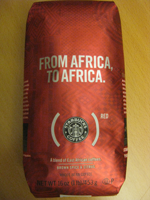It’s a love fest!
Starbucks, in partnership with RED, recently announced a plan to have musicians in 156 countries participate in a Global Sing-along, which produced this totally adorable video:
What does this have to do with the price of (coffee) beans? The All-You-Need-is-Love fest is part of a giant global plan to save the continent of Africa from dying of AIDS (and also maybe sell some coffee and reap the marketing benefits of associating their brand with the compassionate, virtuous, saving Africa image).
If you spend $15 at Starbucks, they’ll give you a CD with above song on it (supplies limited!), and donate a dollar to the Global Fund. It gets more convoluted from there: Go online to the Starbucks love website and draw a cutesy love card to trigger another donation from Starbucks to the Global Fund, this time of 5 cents. Finally, if you upload a video facing your computer camera and singing goofily along to the Beatles classic, Starbucks will toss the GF another nickel.
It's almost enough to make you forget that if you bypassed Starbucks all together and just donated your $15 bucks to the Global Fund you’d be helping…15 times more.
 From Aid to Equality
From Aid to Equality



 I was curious about what the going rate is these days for attracting customers who want to save Africa. Five cents was a little lower than I expected.
I was curious about what the going rate is these days for attracting customers who want to save Africa. Five cents was a little lower than I expected.